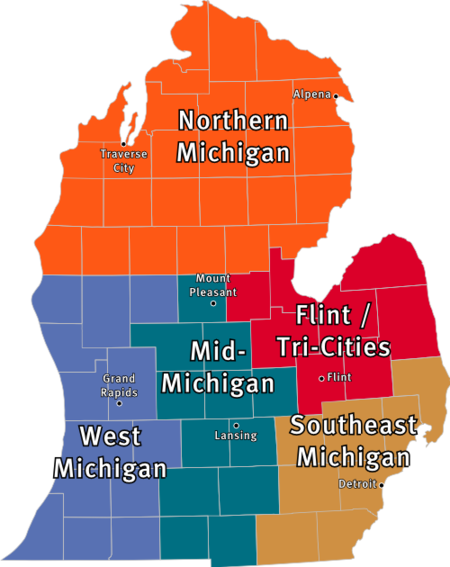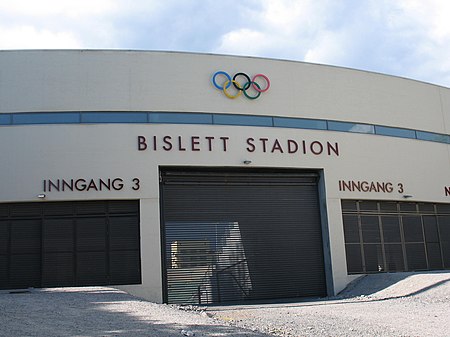Sociology of human consciousness
|
Read other articles:

Bitter herbs eaten during Passover Grated horseradish mixed with cooked beets (known as chrein), romaine lettuce, and horseradish root, which should be freshly grated Passover Seder plate, maror on the lowest plate Maror (Hebrew: מָרוֹר mārôr) are the bitter herbs eaten at the Passover Seder in keeping with the biblical commandment with bitter herbs they shall eat it. (Exodus 12:8). The Maror is one of the symbolic foods placed on the Passover Seder plate.[1] Biblical source In s…

Cet article est une ébauche concernant le Michigan. Vous pouvez partager vos connaissances en l’améliorant (comment ?) selon les recommandations des projets correspondants. La région Nord du Michigan est en orange sur la carte Le Nord du Michigan (en anglais : Northern Michigan) est une région de l'État américain du Michigan. Il peut plus correctement être décrit comme « le Nord du Michigan inférieur », car le nom est rarement utilisé pour décrire la péninsule…

Pour les articles homonymes, voir Popeye (homonymie). Popeye Village fictif de Sweethaven, devenu un parc d'attractions à Malte. Données clés Titre québécois Popeye Titre original Popeye Réalisation Robert Altman Scénario Jules Feiffer Musique Harry Nilsson Acteurs principaux Robin WilliamsShelley Duvall Sociétés de production Paramount PicturesWalt Disney Productions Pays de production États-Unis Genre MusicalComédieAventure Durée 114 minutes Sortie 1980 Pour plus de détails, voir …

SF3B3 المعرفات الأسماء المستعارة SF3B3, RSE1, SAP130, SF3b130, STAF130, splicing factor 3b subunit 3 معرفات خارجية الوراثة المندلية البشرية عبر الإنترنت 605592 MGI: MGI:1289341 HomoloGene: 6579 GeneCards: 23450 علم الوجود الجيني الوظيفة الجزيئية • GO:0001948، GO:0016582 ربط بروتيني• RNA binding• ربط حمض نووي• GO:0032403 protein-containing complex binding الم…

Сельское поселение России (МО 2-го уровня)Новотитаровское сельское поселение Флаг[d] Герб 45°14′09″ с. ш. 38°58′16″ в. д.HGЯO Страна Россия Субъект РФ Краснодарский край Район Динской Включает 4 населённых пункта Адм. центр Новотитаровская Глава сельского посел…

Stadium at Oslo, Norway Bislett Stadium (Bislett stadion)Lekegrinda (old stadium)LocationBislett0168 OsloOwnerOslo MunicipalityOperatorOslo MunicipalityCapacity15,400 (Athletics, football)SurfaceGrassConstructionBroke ground1917Opened1922Construction cost€55 Million (Euros)ArchitectC. F. Møller ArchitectsTenantsVålerenga Fotball (1944–1999)Skeid Fotball (2007–present)Lyn Fotball (2010, 2014-present) Bislett Stadium[1][2][3] (Norwegian: Bislett stadion) is a sports…

Meteorological agency of the People's Republic of China China Meteorological Administration中国气象局Zhōngguó Qìxiàng JúEmblem of the People's Republic of ChinaLogo of CMAHeadquarters of CMAAgency overviewFormedDecember 8, 1949; 74 years ago (1949-12-08)Superseding agencyCentral Military Commission Meteorological Bureau Central Weather BureauJurisdictionMainland ChinaHeadquartersBeijingMinister responsibleChen Zhenlin [zh], DirectorParent agencyState Coun…

Evan McMullinMcMullin pada 2016LahirDavid Evan McMullin2 April 1976 (umur 48)Provo, Utah, Amerika SerikatPendidikanUniversitas Brigham Young (Sarjana)Universitas Pennsylvania(Magistrat)Partai politikIndependen (2016–kini)Partai Republik (sebelum 2016)Situs webSitus web resmi David Evan McMullin[1] (lahir 2 April 1976) adalah seorang aktivis politik Amerika Serikat dan mantan pejabat operasi Central Intelligence Agency (CIA) yang maju sebagai seorang independen pada pemilihan umum …

Lok Sabha constituency in Gujarat Kachchh GJ-1Lok Sabha constituencyConstituency detailsCountryIndiaRegionWestern IndiaStateGujaratAssembly constituenciesAbdasaMandviBhujAnjarGandhidham(SC) RaparMorbiEstablished1952ReservationSCMember of Parliament17th Lok SabhaIncumbent Vinod Chavda PartyBharatiya Janata PartyElected year2019 Kachchh Lok Sabha constituency (formerly Kutch Lok Sabha constituency) is one of the 26 Lok Sabha (parliamentary) constituencies in Gujarat state in western India. Kachchh…

مروان كيالي معلومات شخصية الميلاد سنة 1951 بيروت الوفاة سنة 1988 (36–37 سنة) قبرص اللغات العربية تعديل مصدري - تعديل مروان إبراهيم الكيالي (ولد في بيروت عام 1951 وقتل في ليماسول عام 1988)، سياسي وقائد عسكري فلسطينيمن حركة فتح، كان نائب قائد كتيبة الجرمق ومساعدًا �…

باهيروفي علم شعار الإحداثيات 45°22′46″N 36°17′46″E / 45.379444444444°N 36.296111111111°E / 45.379444444444; 36.296111111111 تقسيم إداري البلد أوكرانيا روسيا[1] خصائص جغرافية ارتفاع 86 متر عدد السكان عدد السكان 3894 معلومات أخرى منطقة زمنية ت ع م+02:00 (توقيت قياسي)، …

4th Oklahoma LegislatureLeadershipPresident of the Senate:J. J. McAlester (D) President Pro Tem of the Senate:C. B. Kendrick (D) Speaker of the House:J. H. Maxey (D) Composition:Senate 34 10 House 78 19 The Fourth Oklahoma Legislature was a meeting of the legislative branch of the government of Oklahoma, composed of the Oklahoma Senate and the Oklahoma House of Representatives. The state legislature met in the India White Temple in Oklahoma City, in regular session fro…

American football player and coach (born 1963) Karl DorrellBiographical detailsBorn (1963-12-18) December 18, 1963 (age 60)Alameda, California, U.S.Playing career1983–1986UCLA Position(s)Wide receiverCoaching career (HC unless noted)1989UCF (WR)1990–1991Northern Arizona (OC/WR)1992–1993Colorado (WR)1994Arizona State (WR)1995–1998Colorado (OC/WR)1999Washington (OC/WR)2000–2002Denver Broncos (WR)2003–2007UCLA2008–2010Miami Dolphins (WR)2011Miami Dolphins (QB)2012–2013Houston T…

دافيد برنياع (بالعبرية: דוד ברנע) مدير الموساد في المنصب24 مايو 2021 يوسي كوهين معلومات شخصية الميلاد 29 مارس 1965 (59 سنة) عسقلان مواطنة إسرائيل الحياة العملية المدرسة الأم مدرسة قيادة جيش الدفاع الإسرائيلي الإعدادية الداخلية معهد نيويورك للتكنولوجيا المهنة…

This article relies largely or entirely on a single source. Relevant discussion may be found on the talk page. Please help improve this article by introducing citations to additional sources.Find sources: Members of the South Australian House of Assembly, 1868–1870 – news · newspapers · books · scholar · JSTOR (December 2022) This is a list of members of the fifth parliament of the South Australian House of Assembly, which sat from 31 July 1868 until 2 …

Current delegationCatherine Cortez Masto (D)Jacky Rosen (D) Nevada was admitted to the Union on October 31, 1864 and has been represented in the United States Senate by 28 people. Its current U.S. senators are Democrats Catherine Cortez Masto (class 3, serving since 2017) and Jacky Rosen (class 1, serving since 2019), making it one of only four states alongside Minnesota, New Hampshire and Washington to have two female U.S. senators. Nevada has been represented by 14 Republicans and 14 Democrats…

National Library of Israel, Jerusalem Modern Jewish historiography is the scholarly analysis of Jewish history into the modern era. While Jewish oral history and the collection of commentaries in the Midrash and Talmud are ancient, with the rise of the printing press and movable type in the early modern period, Jewish histories and early editions of the Torah/Tanakh were published which dealt with the history of the Jewish religion, and increasingly, national histories of the Jews, Jewish people…

2004 Men's Olympic Football TournamentTournament detailsHost countryGreeceDates11–28 AugustTeams16 (from 6 confederations)Venue(s)6 (in 5 host cities)Final positionsChampions Argentina (1st title)Runners-up ParaguayThird place ItalyFourth place IraqTournament statisticsMatches played32Goals scored101 (3.16 per match)Attendance401,415 (12,544 per match)Top scorer(s) Carlos Tevez(8 goals)← 2000 2008 → International football competition Foo…

United States Army and Confederate States Army officer This article is about the Confederate officer in the American Civil War. For the Union officer in the same war, see Robert Anderson (Civil War). For the New York politician, see Robert H. Anderson (politician). For other people, see Robert Anderson (disambiguation). Robert Houstoun AndersonRobert Houstoun AndersonBorn(1835-10-01)October 1, 1835Savannah, Georgia, USDiedFebruary 8, 1888(1888-02-08) (aged 52)Savannah, Georgia, USPlace of b…

Heavy field gun 152-mm gun model 1910/34 152-mm gun M1910/34 in the Artillery Museum, St Petersburg, RussiaTypeHeavy field gunPlace of originSoviet UnionProduction historyNo. built275SpecificationsMassCombat: 7,100 kg(15,653 lbs)Travel: 7,820 kg(17,240 lbs) (with limber)Length8.10 m (26 ft 7 in)Barrel lengthBore: 4.24 m (13 ft 11 in) L/27.9Overall: 4.40 m (14 ft 5 in) L/29 (without muzzle brake)Width2.34 m (7 ft 8 in…

